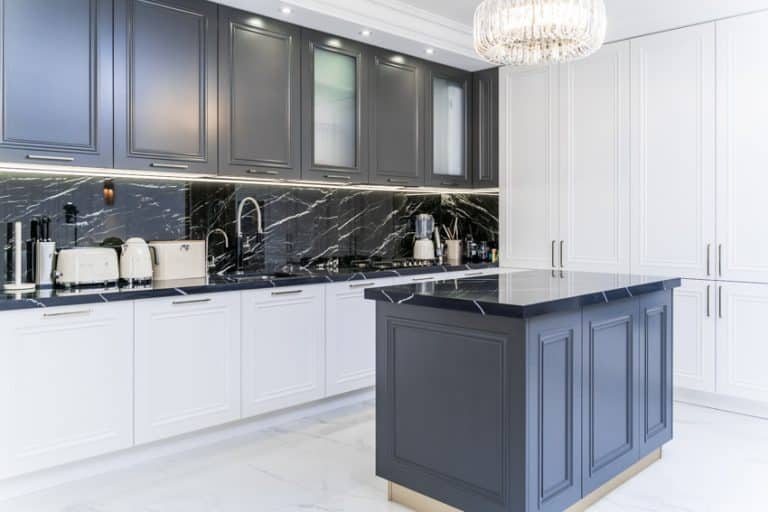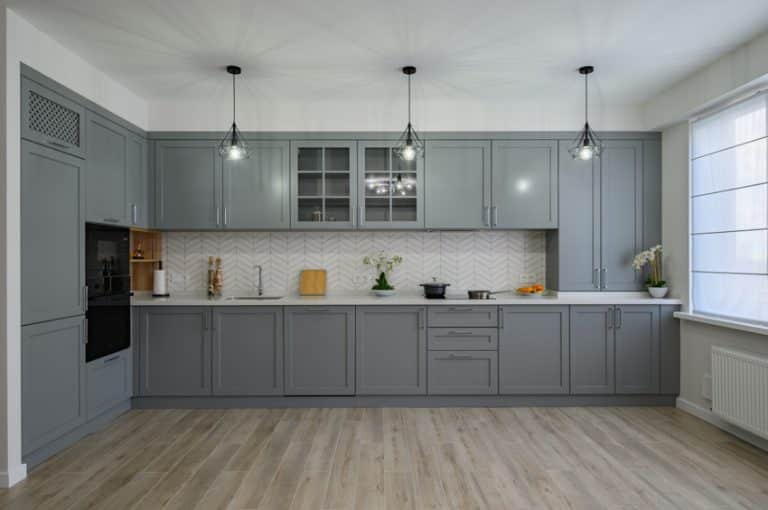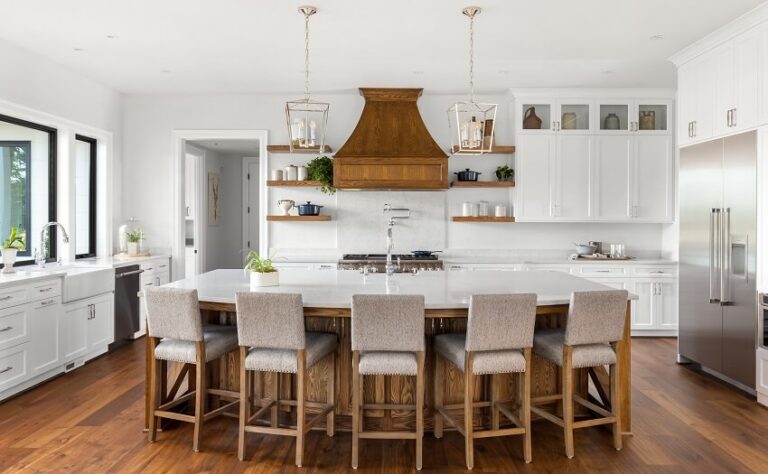Calcite Countertops (Types & Pros and Cons)
See calcite countertops and discover what they are, the different types, their pros and cons, cost, cleaning & care tips and how they compare with other types of countertop materials.
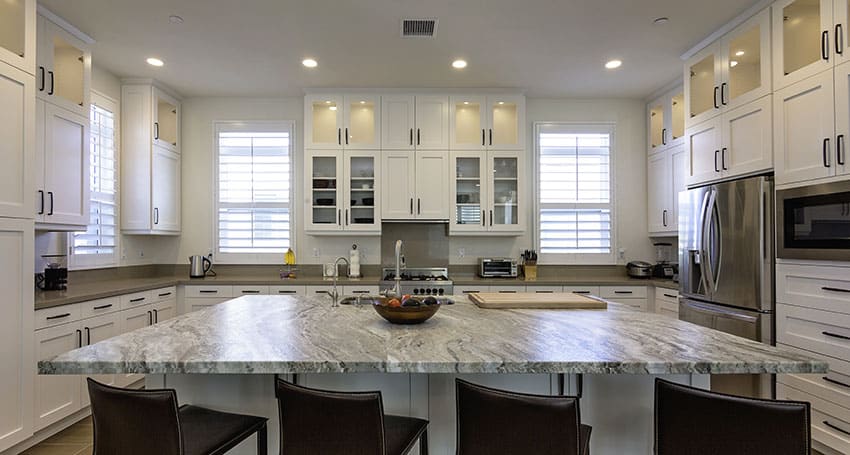
Calcite is a naturally occurring mineral found in many different types of stone, including limestone, marble, and travertine. Calcite countertops are becoming increasingly popular in homes and commercial kitchens because of their beauty and durability.
What Are Calcite Countertops?
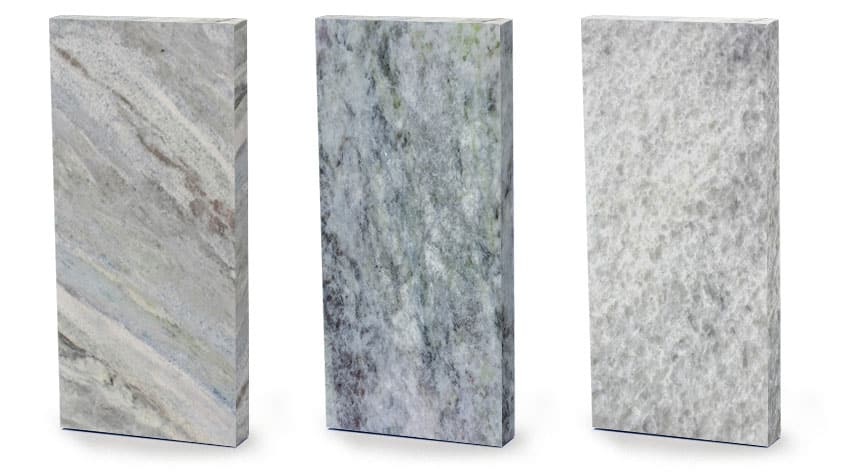
When pure, calcite is typically translucent, transparent, opaque, or white. However, due to impurities, it may be of almost any color – reddish, pink, yellow, greenish, blueish, lavender, black, or brown. It has soft veins of light blue, gray, green, and other light colors with a grain structure similar to quartz.
Calcite is soft, can scratch, etch and stain just like marble, and is used for bathroom and kitchen countertops. Since calcite is a natural stone, it offers a natural beauty in this material’s hues, patterns, and veins, making people instinctively feel drawn to them. No two slabs of this natural stone are the same, making it a unique material for countertops.
Calcite Countertops Pros And Cons
Here’s the pros and cons of calcite countertops starting with the benefits.
Pros of Calcite Countertops
Beautiful appearance – Calcite countertops have increasingly become a more popular type of stone countertop over the years. One of the most significant advantages of having a calcite countertop in your home is because of the added value it gives since it offers a sophisticated and deluxe appearance to any countertop design.
Affordable option – Its durability, beauty, and price point contribute to its popularity. Calcite countertop gives you a more affordable option than marble, granite, or quartzite while still getting that stone countertop appeal.
Unique countertop material – Homeowners love the uniqueness of calcite’s natural origin and development. Its pattern and colors can enhance your space’s look and warmth. Calcite countertops have a classic, timeless appearance that will allow it to blend with different décor and design styles.
Moderately durable – Even if calcite is a soft stone, it will stand up to daily wear and tear as a countertop in your bathroom or kitchen if appropriately treated. It is also heat-resistant.
Cons of Calcite Countertops
Needs more maintenance than many other types of countertops – Calcite has several disadvantages, requiring more maintenance and upkeep.
Scratches easily – Since calcite is a soft and porous stone, it does tend to scratch and stain easily if not cared for properly.
Can be damaged by some liquids and cleaners – The calcite countertop is also sensitive and can be damaged by acids. Traditional kitchen cleaners, scrubbing sponges, and acidic liquids will scratch and dull a calcite countertop.
Use sealers and neutral pH cleaners designed for soft stone to preserve its elegant beauty and appearance. This stops stains and discoloration from building up so that liquid doesn’t seep into the stone due to its porous nature.
Calcite Hardness
Calcite is a popular choice for countertops due to its beautiful appearance and excellent durability. This mineral is naturally hard, with a rating of 3 on the Mohs scale.
This makes it a good choice for countertops, as it can withstand daily wear and tear without scratching or breaking easily. Additionally, calcite is dense, making it the perfect material for high-traffic areas in your home.
Calcite is worth considering if you are looking for a durable and attractive material for your countertops. With its beautiful colors and a high degree of hardness, it will surely add style and functionality to your kitchen or bathroom.
Calcite Countertops Cost
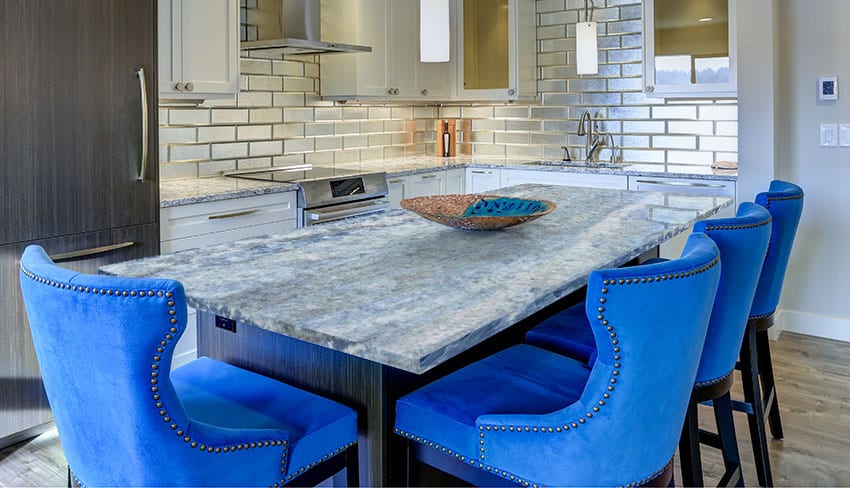
“Calcite is an excellent option if you want to avoid the high costs of marble but still get an attractive countertop.” explains interior designer Maria Bott.
It is a unique and beautiful material that is less expensive but requires some effort on its upkeep – especially with stains from food items.
Calcite is a popular choice for countertops due to its aesthetic appeal, durability, and low cost. There are several grades of calcite, and the price ranges from $55 to $125 per square foot.
Maintenance costs can be moderate to high, depending on the quality of the calcite. To save money on calcite countertops, choose non-premium grades and get several competitive bids on installation.
Calcite slabs are familiar to this industry. Still, recently they’ve become a focus of many stone suppliers due to an increasing number who want them- especially those looking at more natural options that offer the feel of less synthetic than traditional polished products.
As demand for white-colored stones is rising, so too does the production and sales of calcite countertops.
Types Of Calcite Kitchen Countertops
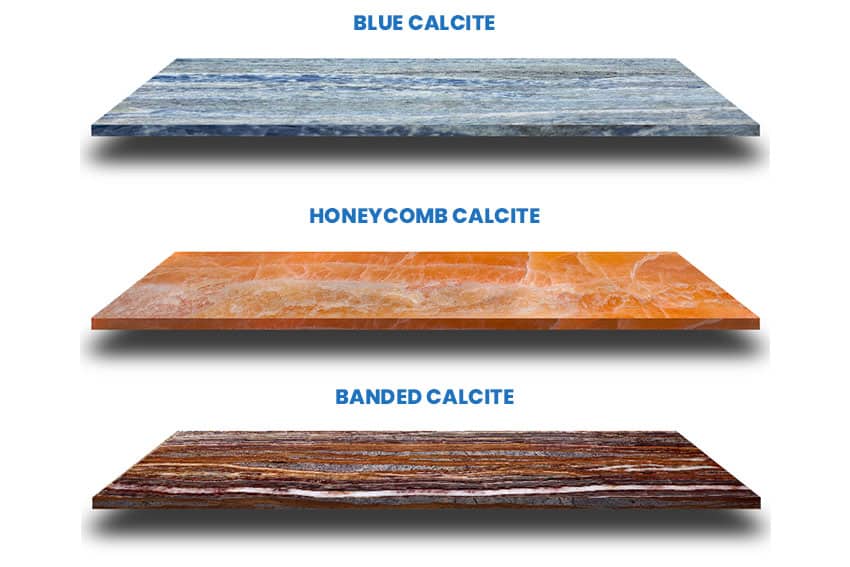
Designers who choose calcite’s cold tones for kitchen countertop offers excellent movement when covered with this fascinating stone.
• Honeycomb calcite countertops – discovered and mined exclusively in Utah, the name honeycomb calcite comes from the remarkable honeycomb appearance in the stone slabs. This stone is unlike any other form of calcite because it has a variety of colors, patterns, and translucency.
The most distinctive feature that sets this apart from all others is its ability to accept high polish that doesn’t quickly fade in the sunlight like some stones do when exposed over time.
Another unique trait would be in its color range from pale sunshine-lemon yellow to rich honey-golden amber depending on thickness – which is partly attributed to sulfur deposits at time formation.
There are also patterns across tight “honey sugar” look with small hexagonal cells grouped closely together throughout its translucency or clear transparency.
• Banded calcite countertops – Most slabs of onyx are what a geologist would call banded calcite. Banded Calcites share its roots known as calcium carbonate, the same mineral that makes up limestone, marble, and travertine.
This countertop is a beautiful rock with an otherworldly quality and appearance that belies its sparkling translucence, which creates a magical effect when light hits it right or is backlit with gentle candle flames dancing across its surfaces in different hues of yellow-brown-white gold against deep black backgrounds.
Cleaning Calcite Kitchen Countertops
Calcite is a softer stone than granite or quartz, so it needs to be cleaned with more care. Here are some tips for cleaning your calcite countertops.
First, make sure you always use a soft cloth or sponge to wipe up spills as soon as they happen.
Also, avoid using harsh cleaners because this can damage the surface of Calcites in general- but if there’s something really stuck just give it soaking with baking soda water then scrub away gently until all stains come out.
The last step is to rinse well when done washing so that none remains behind which may lead again staining over time. With just a little care, your calcite countertops will stay beautiful and sparkling for years.
Calcite Countertop Care
Calcite will take a little time to maintain, unlike other natural stones you can use for your countertop. Since calcite is more porous than stone and usually light in color, it can be easily stained. It should be sealed upon installation as well as annually to prevent staining.
Choose a water-based sealant and use a cleaning spray with sealing properties weekly or monthly for added protection.
To prevent your calcite countertops from staining or becoming discolored, wipe up any spills immediately. If a stain does occur, you can treat it by mixing one cup of flour with 2 to 3 tablespoons of hydrogen peroxide to make a paste.
To avoid scratching the surface of your countertop, use cutting boards and placemats when working with knives. You can also opt for steel wool or a small amount of polishing compound if you find minor scratches on these surfaces.
Quartzite vs. Calcite

Both can scratch easily with even minimal contact, so care must accordingly go into handling these natural materials when selecting where you want your slabs placed – but this also means each has unique qualities depending on what purpose it will serve.
Both stones can be tough and durable, but they have limitations. For example, calcite is not as strong against impact as other stones like quartzite; however, this doesn’t mean you should avoid using it altogether. Quartzites also offer better heat resistance to high temperatures and scratching than calcite. With proper use, you shouldn’t have any problems with either one.
The prices for both materials are more affordable than granite and marble, making them a mid-range option when it comes to pricing. Quartzite and calcite are suitable substitutes for granite and marble for a natural stone countertop.
Although they have some characteristics a bit weaker than granite and marble, they are similar in appearance. Calcite is considered one of the most beautiful stones with a smooth, fine-grained appearance; quartzite often looks like marble and is usually white-colored.
Calcite vs. Quartz

Durability is essential in high-traffic or high-use areas like the kitchen; quartz is less likely to crack and chip with wear. Unlike calcite which is soft and may scratch, etch and stain, quartz doesn’t easily stain or scratch.
Quartz kitchen countertops are also low maintenance since they are less porous, which is vital in the kitchen where sanitation is essential, and staining is a concern. Because quartz is less porous, they are stain resistant and don’t draw in moisture which can harbor bacteria.
Quartz doesn’t require regular maintenance, and when it is time for cleaning, you won’t need any harsh chemicals or expensive products to clean the surface. Quartz countertops come in various styles and look that has a rich, luxurious style that elevates the design of any kitchen or bathroom.
Calcite vs. Granite

Granite is a harder natural stone, having a 6-8 on the Moh’s Scale of Mineral Hardness. It doesn’t require as much maintenance as calcite.
However, granite is a porous material, which means it can transfer liquids through the material and should be sealed with a penetrating sealer. Granite will need to be re-sealed periodically for around three to five years, but it could be more often if the granite is exposed to the outside elements or sees higher usage.
Most granite surfaces will not show signs of wear immediately; more significant scratches or minor scratches that make the granite appear dull typically show about 5-15 years after it is installed. When granite begins to dull, it can be refinished using diamond abrasives to look new.
Calcite vs. Marble

Calcite is more affordable than marble, but marble countertops may be a superior interior design choice over calcite. While calcite is more readily available, marble is one of the market’s most expensive decorative and architectural stones. It varies in cost depending on the pattern and veining, the quarry’s location, demand, availability, slab choice, and thickness.
Both calcite and marble are highly vulnerable to acid. Thus, lemonade or vinegar can leave permanent etch marks on both countertops. Both calcite and marble countertop require professional resurfacing and re-honing.
One of the similarities between calcite and marble similarities is that both these natural stones need sealing. Sealing calcite and marble increases their durability, maintains their natural appearance, prevents stains, and makes them easier to maintain.
Visit our article on the most durable kitchen countertops for more related content.
Written by Maria Bott, Freelance Interior Designer

